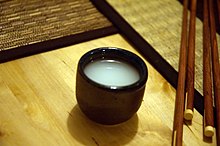
Real ale is the name coined by the Campaign for Real Ale (CAMRA) for beer that is "brewed from traditional ingredients, matured by secondary fermentation in the container from which it is dispensed, and served without the use of extraneous carbon dioxide".

Sake or saké, also referred to as Japanese rice wine, is an alcoholic beverage of Japanese origin made by fermenting rice that has been polished to remove the bran. Despite the name Japanese rice wine, sake, and indeed any East Asian rice wine, is produced by a brewing process more akin to that of beer, where starch is converted into sugars that ferment into alcohol, whereas in wine, alcohol is produced by fermenting sugar that is naturally present in fruit, typically grapes.

Wheat unfiltered beer is a top-fermented beer which is brewed with a large proportion of wheat relative to the amount of malted barley. The two main varieties are German Weizenbier and Belgian witbier; other types include Lambic, Berliner Weisse, and Gose.

There is a long history of alcoholic drinks in China. They include rice and grape wine, beer, whisky and various liquors including baijiu, the most-consumed distilled spirit in the world.

Apple cider is the name used in the United States and Canada for an unfiltered, unsweetened, non-alcoholic beverage made from apples. Though typically referred to simply as "cider" in North America, it is not to be confused with the alcoholic beverage known as cider in other places, which is called "hard cider" in the US. Outside of the United States and Canada, it is commonly referred to as cloudy apple juice to distinguish it from clearer, filtered apple juice and hard cider.

Shōchū is a Japanese distilled beverage. It is typically distilled from rice, barley, sweet potatoes, buckwheat, or brown sugar, though it is sometimes produced from other ingredients such as chestnut, sesame seeds, potatoes, or even carrots.

Baijiu, or shaojiu (烧酒/燒酒), is a colorless Chinese liquor typically coming in between 35% and 60% alcohol by volume (ABV). Each type of baijiu uses its own type of qū for fermentation to create a distinct and characteristic flavor profile.

Makgeolli, sometimes anglicized to makkoli, is a Korean alcoholic drink. It is a milky, off-white, and lightly sparkling rice wine that has a slight viscosity, and tastes slightly sweet, tangy, bitter, and astringent. Chalky sediment gives it a cloudy appearance. As a low proof drink of six to nine percent alcohol by volume, it is often considered a "communal beverage" rather than hard liquor.
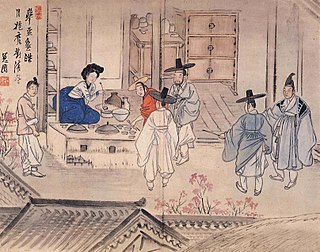
Korean cuisine has a wide variety of traditional alcoholic drinks, known as sul (술). Many of these drinks end with the Sino-Korean word -ju, and some end with the native Korean word -sul. The Sino-Korean -ju is not used as an independent noun.
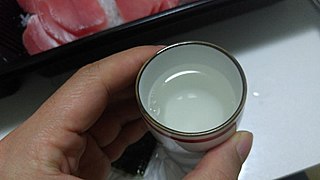
Cheongju, sometimes romanized as Chungju, is a clear, refined rice wine of Korean origin.
Choujiu is a type of Chinese fermented alcoholic beverage brewed from glutinous rice. It is very thick and has a milky white color, which is sometimes compared to jade.photo Fermentation is carried out by a combination of the fungus Aspergillus oryzae, which converts the rice starches into fermentable sugars, and yeast, which converts the sugars into alcohol. Varieties of lactic acid bacteria are also commonly present in the fermentation starter. The traditional Chinese name of the fermentation starter is qū.

Sake kasu (酒粕) or sake lees is the name given to the pressed lees left over from the production of sake. It is used as a cooking ingredient that is white in color, having a paste-like texture. The taste is fruity and similar to sake itself. A by-product of Japanese sake production, it typically contains 8% alcohol, has high nutritional value, and might have health benefits.
Philip Harper (1966) is a British-born sake brewer in Japan. He is the first immigrant to have earned the title tōji or master sake brewer. He has worked for a variety of sake breweries since 1991. His hope is to broaden the market of Japanese sake - bringing its taste to other parts of Asia, Europe, and North America - and to revive sake as the national, cultural drink of Japan. Harper is the author of two books on sake: The Insider's Guide to Sake, and The Book of Sake: A Connoisseurs Guide. He is also featured in a chapter of Michael Booth's 2009 travel book Sushi and Beyond: What the Japanese Know About Cooking.

Beer is often made from barley malt, water, hops and yeast and so is often suitable for vegans and vegetarians. Some beer brewers add finings to clarify the beer when racking into a barrel. Finings can include plant-derived products, like Irish moss, or animal-derived products, like isinglass and gelatin.
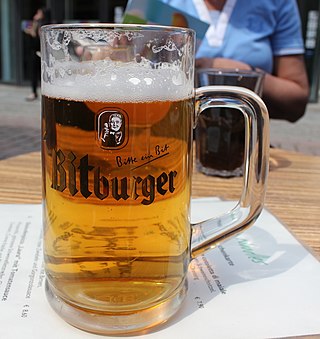
Filtered beer refers to any ale, lager, or fermented malt beverage in which the sediment left over from the brewing process has been removed. Ancient techniques included the use of straw mats, cloth, or straws, and frequently left some sediment in the drink. Modern filtration, introduced at the end of the 19th century, uses a mechanical process that can remove all sediment, including yeast, from the beer. Such beer is known as bright beer and requires force carbonation before bottling or serving from a keg. In the United Kingdom, a beer which has been filtered in the brewery is known as "brewery-conditioned", as opposed to unfiltered cask ales.

Huangjiu is a type of Chinese alcoholic beverage most popular in the Jiangnan area. Huangjiu is brewed by mixing boiled grains including rice, glutinous rice or millet with qū as starter culture, followed by saccharification and fermentation at around 13–18 °C (55–64 °F) for fortnights. Its alcohol content is typically 8% to 20%.
This glossary of sake terms lists some of terms and definitions involved in making sake, and some terms which also apply to other beverages such as beer. Sake, also referred to as a Japanese rice wine, is an alcoholic beverage made by fermenting rice that has been polished to remove the bran. Unlike wine, in which alcohol is produced by fermenting sugar that is naturally present in fruit, sake is produced by a brewing process more akin to that of beer, where starch is converted into sugars which ferment into alcohol.
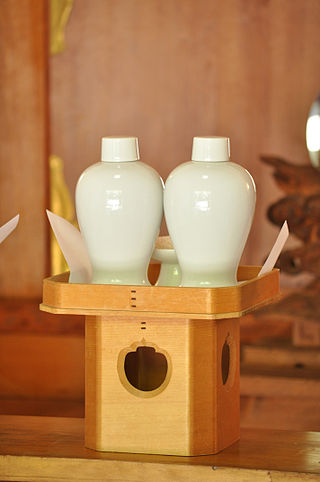
Omiki(お神酒) is an offering of sake or other alcoholic drinks offered to gods in Japanese Shinto.
Doburoku Matsuri or Doburoku Festival is a festival held at shrines and other places where doburoku is served. Doburoku is a Japanese sake that holds religious significance. Sanctified Doburoku is called Omiki and is accompanied by a series of rituals.
